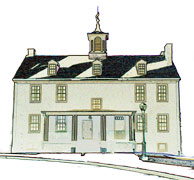




 | | | ||
 | | |||
 | | | | |
 | | |||
 | | |||
| A 1980 PERSPECTIVE The township has long been recognized as a high quality, primarily residential community along the famed Main Line of the Pennsylvania Railroad with easy access to Philadelphia. Demographic studies indicate that the phenomenon of greatly reduced family size, first noticed in the 1970 census, continues. Couples wait longer to have children, and then have fewer than their counterparts twenty years earlier. Five neighborhood schools have been closed in recent years. School officials will probably offer greater use of school facilities to adults, thereby increasing efficient use of classrooms, shops, gymnasiums, and playing fields. Statistics prove that people live longer than formerly, and therefore both public and private recreational facilities provide leisure-time activities for a growing number of older people. Adults spend more time in pursuit of physical conditioning than ever before. Less time and money to spend on maintenance of property forecasts a decline in the traditional single-family dwellings, and an increase in townhouses, cluster developments, planned residential communities, and apartments, leased or privately owned. The large house surrounded by spacious lawns will give way to the clustered-homes concept, which is a feasible alternative as the township attempts to retain the amenities inherent in the open character of its development. The cost of real estate and the unprecedented high interest rates for borrowed money place home ownership out of the financial reach of many. Shared living and shared costs provide an acceptable alternative. Expensive heating fuels necessitate more efficient building construction, which also increases the popularity of clustered dwelling units. A major problem facing Lower Merion in the future will be the ultimate fate of large mansions located throughout the township. A neighborhood may retain its character if these large structures are converted into condominiums or rental apartments. Neighborhood opposition has prevented such conversion in many places in the past with the result that magnificent houses have been razed. Neighborhood retail commercial centers and streets of shops once again became popular for family shopping when gasoline costs rose. Distant malls are losing their appeal. Increased shopping close to home, the completion of the Blue Route, and improvements to the Schuylkill Expressway should bring about a reduction in the number of vehicles traversing the township. Proximity to Philadelphia and its diverse population continues to provide both benefits and problems. Metropolitan advantages are found in the sports arenas, medical centers, and cultural institutions of the city; on the other hand, crime spilling over city boundaries continues to force suburban residents to increase participation in community patrols in cooperation with the police. The township continues to be made up of many neighborhoods, and the descendants of immigrants of various nationalities provide a stimulating ethnic mixture. Attractive homes and estates, exclusive shops and department stores, luxurious apartment complexes, stately churches, excellent public, private, and parochial schools and colleges all combine to form the cultural fabric of Lower Merion. The township boasts an interested, well-educated citizenry and dedicated, intelligent elected and appointed municipal officials. It retains quiet woods and stream valleys relatively close to retail commercial centers. Phyllis C. Maier |